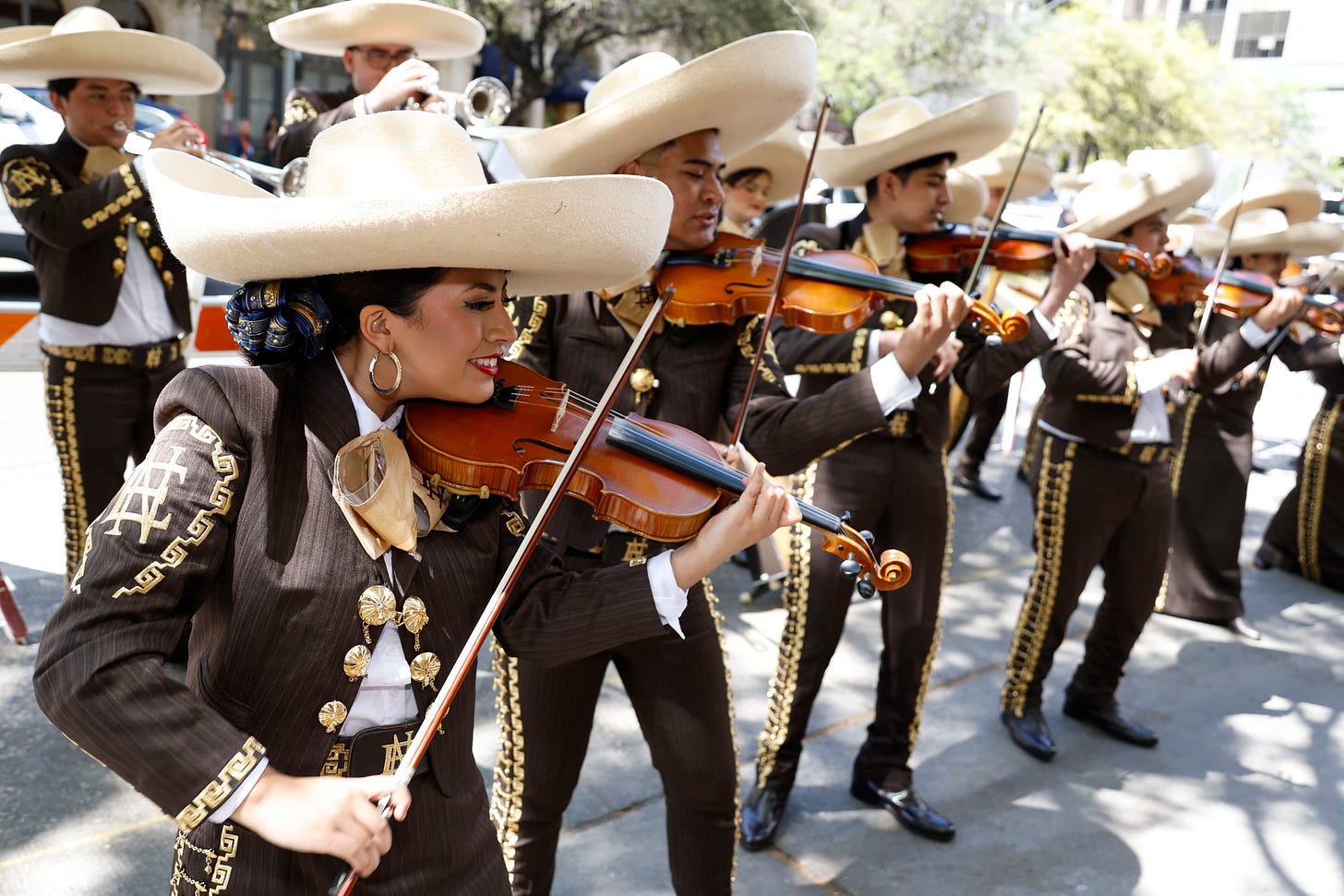Mariachi: Born of Indigenous and Rural Rhythms
After the Spanish conquest, Coca musicians incorporated European instruments like the harp, guitar, and vihuela into their rituals.
The story is colorful, and goes something like this:
In the mid-19th century, French explorers, fortune-seekers, and a few idealists landed on Mexico’s Pacific coast in search of gold and glory. Some had permission; others didn’t. They rarely found what they came for. Many were arrested or executed.
But a few, inspired by the spirit of Humboldt, wandered the verdant hills of what’s now Jalisco and Nayarit, taking notes on the flora, fauna, and local customs.
One day, so the tale goes, a French traveler stumbled upon a lively village wedding. “Voilà un mariage!” he supposedly cried, watching musicians play amid a crowd of revelers.
According to this version, French ears began to associate mariage—the French word for marriage—with the musicians and the festive music they heard at Mexican weddings. Pronounce them, and they sound quite similar. The name stuck, the story says, and mariachi was born.
It’s a charming story. But it isn’t true.
It’s Not Mariage
The French-origin myth gained popularity in the 20th century and became something of a folk explanation, repeated by countless tour guides, travel brochures, and storytellers. It has that fairy-tale quality people love—colonial misunderstandings, serendipity, a splash of romance. But the evidence doesn’t hold up.
And in truth, it is a little colonialist in spirit. How come an indigenous culture come up with something so successful? The implication is subtle but familiar: that an indigenous culture couldn’t have come up with something so successful. Surely, the thing must have a European involved.
In fact, it points to a much deeper, older origin—one rooted not in Europe of French visitors, but in the indigenous languages and traditions of western Mexico.
One thing we can be sure of, by the late 1800s, mariachi was already a known term in Mexican newspapers. An 1888 article mentions a mariachi group playing at a railroad inauguration. Another in 1880 describes a local cacique manipulating elections in Amatitán, Jalisco, with the help of two things: soldiers (to intimidate) and a mariachi band (to distract).
Roots in Nayarit
So far, these dates might appear to support another French-origin theory, that Napoleon III’s invading army coined the word during the brief reign of Emperor Maximilian and Empress Carlota (1864–1867). But the evidence points even further back.
In fact, the name mariachi appears decades earlier, in civil records from Nayarit. In 1833, a death certificate mentions someone born in a place called El Mariachi. Several ranchos with names like Mariachi and Mariache appear in that region. Even earlier documents describe mariachi as an occupation—meaning the word referred to a kind of performer.
Roots In The Indigenous Word
So what does mariachi actually mean?
One theory traces the word to the Coca people of central Jalisco. After the Spanish conquest, Coca musicians incorporated European instruments like the harp, guitar, and vihuela into their rituals.
Over time, their sacred music shifted toward secular themes—satirical lyrics, danceable rhythms—and became the soundtrack to weddings, baptisms, and even funerals.
By the middle of the 19th century, mariachi was the sonic heart of life on rural haciendas. They played barefoot, in plain clothes, often traveling by mule or on foot from town to town.
As mariachi groups moved into cities, especially Guadalajara, the sound began to evolve. In 1905, a mariachi ensemble led by Justo Villa (not related to the revolutionary Pancho Villa) played for President Porfirio Díaz during Independence Day celebrations in Mexico City. That performance marked mariachi’s arrival on the national stage.
But its most iconic metamorphosis was yet to come.
Jesús The Trumpeter
There’s another legend about a poor trumpeter named Jesús who one day arrived in Cocula, Jalisco, and begged a group of musicians to let him join their mariachi group.
At first, they laughed—trumpets didn’t belong in mariachi. But Jesús persisted, following the group from gig to gig, echoing their melodies from afar. Eventually, they let him try. To everyone’s surprise, the people cheered him on. The definite mariachi sound—with ear-splitting high staccato trumpet notes—was born.
Whether the story is fact or legend, the addition of the trumpet changed mariachi forever. Some credit this shift to the radio boom of the 1920s and ’30s, especially the broadcasts of the XEW radio station in Mexico City. The trumpet’s sharp, high-pitched voice was necessary to help the music cut through static and reach a broader audience. The influence of jazz and big band music likely played a role as well.
From Local Sound To National Symbol
After the Mexican Revolution, mariachi became politically useful. Presidents from Álvaro Obregón onward used mariachi groups in their campaigns and inaugurations to signal a connection to “the people.” The music became part of the state’s nation-building efforts—rustic yet refined, rural yet national.
By the Golden Age of Mexican cinema in the 1940s and ’50s, mariachi was everywhere—on screens, in plazas, in living rooms. Singers like Jorge Negrete and Pedro Infante helped canonize it. It became not just a musical genre but a cultural register, capable of expressing nostalgia, heartbreak, macho poses, and joy in equal measure.
And The Word “Mariachi”?
So what does the word really mean? Scholars like Gutierre Tibón and local chroniclers from Nayarit argued that mariachi may derive from a word used by the Coca for venado (deer) and for the speed and grace of the animal, much like the music’s rapid tempo. Others believe the word referred to a native tree whose wood was used to make early instruments. Either way, its roots run deep in western Mexico.
In 2011, UNESCO recognized mariachi as an Intangible Cultural Heritage of Humanity. Today, it’s one of Mexico’s most global exports.
So no, mariachi is not a French word.
It comes from somewhere deeper, somewhere older, closer to the soul.




